This easy Cold Soba noodles (Zaru Soba) recipe features buckwheat noodles and a genmaicha tea-infused tsuyu dipping sauce for a light and refreshing dish that's perfect for hot sunny days! It tastes delicious and authentic yet it's easy to make, even for anyone making it for the first time.

Table of Contents
- What is Cold Soba (Zaru Soba)?
- Why You’ll Love This Cold Soba Recipe
- Ingredients You’ll Need to Make Cold Soba At Home
- Joyce's Tips For Making the Best Cold Soba Every Single Time
- How to Make Zaru Soba (Cold Soba) Step by Step
- How To Serve and Eat Cold Soba Noodles
- Make a Soup with the Remaining Tsuyu Dipping Sauce
- Recipe Variation Ideas for Cold Soba
- How to Store Leftover Cold Soba
- More Japanese Recipes You May Like
- Did You Make This Japanese Cold Zaru Soba Noodle?
- Recipe Card
- Other Noodle Recipes You May Like
Cold Soba is a classic Japanese dish that perfectly embodies simplicity and elegance. This refreshing and nutritious meal features chilled buckwheat noodles, traditionally served with a variety of toppings and with an incredibly delicious dipping sauce.
The smooth and slightly nutty flavor of the soba noodles pairs perfectly with the umami-rich sauce, resulting in a delicious balance of tastes and textures.
Whether enjoyed as a light lunch or a satisfying dinner, cold soba is a perfect choice for anyone looking for a healthy and satisfying meal. Plus, the versatility of this dish allows for endless creativity, and you can customize the toppings to your liking which helps to add a burst of color and flavor to each bite!
Read on to learn exactly how to make this delicious cold soba recipe today!
What is Cold Soba (Zaru Soba)?
Zaru soba (ざるそば) is a Japanese chilled soba noodle dish made with buckwheat flour noodles. It is served with a cold tsuyu dipping sauce (also called mentsuyu) which you use to dip your noodles in before slurping it down. It's a very light and refreshing dish to enjoy during the hot summer days, and super quick and easy to make as well.
When I came up with this recipe for zaru soba (cold soba noodles) I wanted to keep it simple and didn't want to slave over the stove. This is where I got the idea of using steeped genmaicha tea idea since it's an easy way to make the dipping sauce as well gives it extra flavor.
That being said, you can also use a simple dashi broth made with dashi powder as well. For extra flavor, you can also sprinkle some furikake seasoning on top of the noodles as well right before you serve them.
What’s best about this dish are the the cold and refreshing noodles, which are particularly enjoyable during the summer. The dipping sauce, tsuyu, adds a savory and umami flavor to the noodles which serves to enhance the taste.
If you're looking for something to serve on the side, you can also try serving it with my charred lemon garlic edamame or Japanese kani salad recipe as well, it's easy to make and only takes 15 from start to finish.
Why You’ll Love This Cold Soba Recipe
Easy to make: This cold soba recipe is incredibly simple and requires minimal cooking skills. All you need to do is cook the soba noodles, make the sauce, and assemble the dish. It is perfect for beginners or those looking for a quick and hassle-free meal.
Versatile: It can be easily customized to suit your taste preferences and dietary restrictions. You can add your favorite vegetables, protein, or spices to enhance the flavor. Whether you’re a vegetarian, vegan, or meat lover, this recipe can be adapted to suit your needs.
Delicious: The combination of chilled soba noodles and the delicious sauce creates a satisfying dish. The sauce is made with a blend of genmaicha tea, soy sauce, mirin and sake that create a perfect balance of umami with delicate flavors.
Healthy: Cold soba noodles are low in calories and fat, making them a great choice for those looking to maintain a healthy diet. They are also a good source of fiber, protein, and nutrients like manganese, magnesium, and thiamine. It is a guilt-free option that doesn’t compromise on taste.
Crowd-pleaser: Whether you’re serving a small group or a large gathering, this cold soba recipe is sure to be a hit. It appeals to a wide range of palates and can be enjoyed by both kids and adults. It is a great option for potlucks, parties, or even a simple weeknight dinner.
Ingredients You’ll Need to Make Cold Soba At Home
All you need are some incredibly simple, pantry-staple ingredients to make this delicious cold soba recipe at home.
Here's an overview of the specific ingredients for this recipe. For the exact ingredients and measurements, please scroll to the recipe card below.
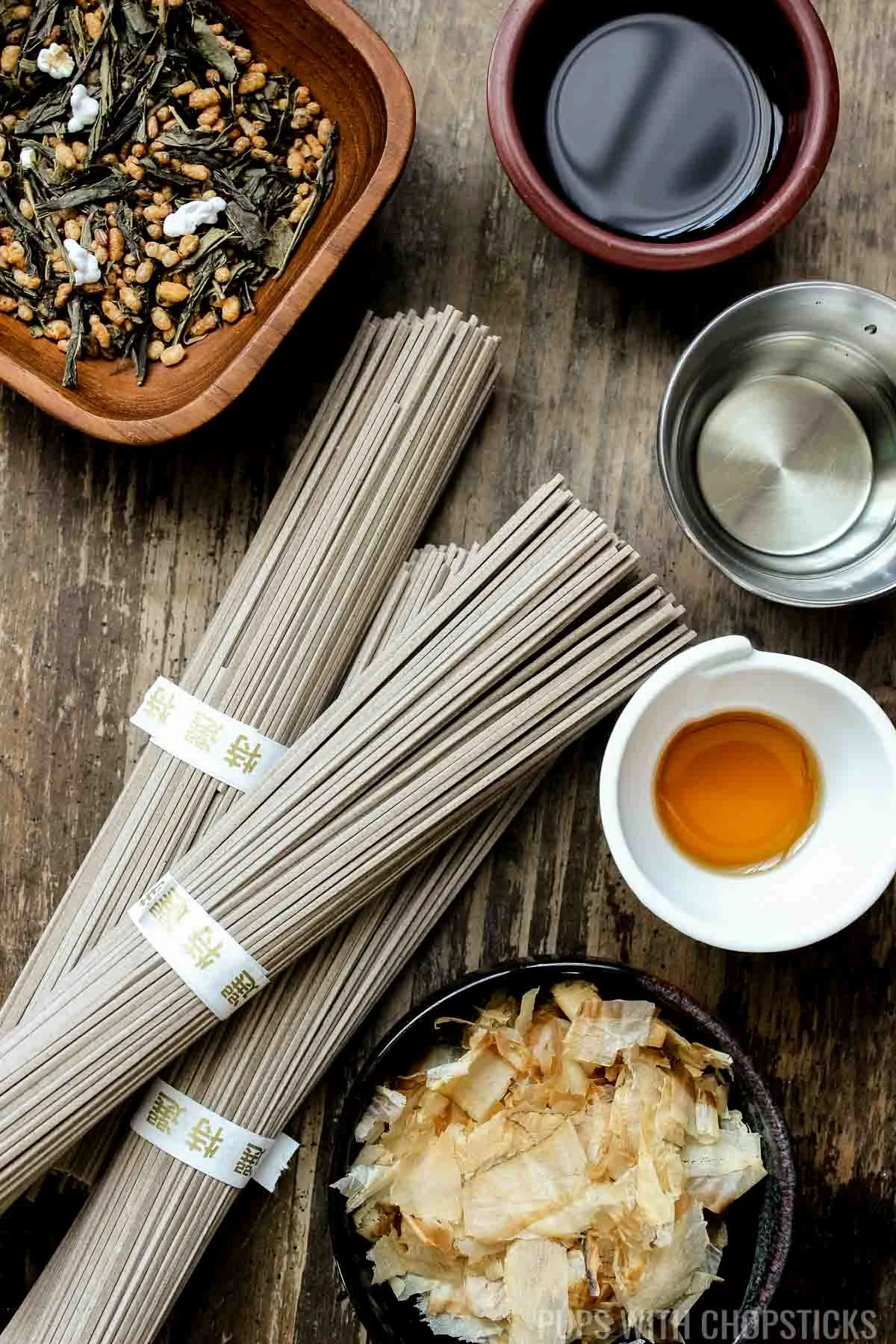
- Soba Noodles: We will be using some soba noodles, which will provide a chewy and flavorful base for your dish. The noodles will absorb the flavors of the dipping sauce, creating a delicious combination of textures and tastes.
- Sesame Oil: We will also be adding some sesame oil to enhance the overall flavor of the dish. The oil will add a nutty and aromatic element to the noodles, giving them a rich and savory taste.
For the Genmaicha Tsuyu Dipping Sauce:
- Genmaicha Tea Leaves: To make the dipping sauce, we will need some genmaicha tea. The tea will infuse the sauce with a unique roasted flavor, complimenting the other ingredients and adding depth to the overall taste. Genmaicha is also known as roasted brown rice green tea and can be found at your local Asian grocery store as well however, tea shops are getting quite popular nowadays, so you may be able to find them at tea shops as well.
- Bonito Flakes: We will also be adding bonito flakes to the dipping sauce, which will provide a rich smoky umami flavor. The flakes are made from dried and fermented fish, adding a depth of flavor that will enhance the overall taste of the dish.
- Soy sauce: We will also use soy sauce in the dipping sauce. The soy sauce will contribute to the savory and salty taste of the sauce, balancing out the other flavors and give it some more umami flavor.
- Mirin: We will be using mirin, a sweet rice wine, to add a touch of sweetness to the dipping sauce. The mirin will help to balance out the flavors of the other ingredients and create a well-rounded and delicious sauce.
- Sake: Along with the mirin, we will be using sake in the dipping sauce. The sake will add a subtle depth of flavor and aroma, enhancing the overall taste of the sauce and giving it a touch of complexity.
For the Toppings (Mix & Match):

- Ginger: We can grate some ginger to add a refreshing and spicy twist to the soba. The ginger will provide a zesty and aromatic element that will compliment the flavors of the noodles and dipping sauce.
- Dried Nori Seaweed Sheet: Another topping option is to cut a dried nori seaweed sheet into slivers and sprinkle it over the dish. The seaweed will add a subtle oceanic seafood flavor and a crispy texture, enhancing the overall taste and presentation. It can usually be found at your local grocery store or Asian supermarket.
- Toasted Sesame Seeds: We can also toasted sesame seeds as a topping to add a nutty and crunchy element to the dish. The sesame seeds will provide a burst of flavor and texture, elevating the overall taste of the noodles.
- Grated Daikon Radish: Grated daikon radish can be used as a topping to add a refreshing, and spicy element to the dish. The radish will provide a subtle sweetness, balancing out the flavors. Daikon radish can usually be found at your local grocery store or Asian supermarket.
- Wasabi: Another topping option is to add a dollop of wasabi for a spicy and pungent kick. The wasabi will add a fiery element, elevating the overall taste of the dish and giving it a unique twist. I used prepared wasabi since this was what I had on hand, and it makes this recipe quick and simple - however if you can get powdered wasabi or fresh wasabi those work as well.
- Green Onions: Finally, finely chopped green onions can be sprinkled on top of the dish to add a fresh and aromatic touch. The green onions will serve to provide a mild onion flavor and burst of color, enhancing the overall taste and presentation of the noodles.
Joyce's Tips For Making the Best Cold Soba Every Single Time
Blow on Foam to Stop Overflowing: It's very easy to overflow the pot when you are boiling soba noodles. When you start to notice a lot of foam building up, blow on it. Blowing on the foam will send it back down so it won't overflow the pot.
Sesame Oil For the Ice Bath is Optional: It is not traditionally added but I find a hint of nuttiness adds a nice flavor to the noodles. A little goes a long, long way, so less is more. I would go with only adding a few drops in and use no more than ¼ teaspoon.
Be Careful With the Wasabi: Prepared wasabi is potent – a little goes a long, long way, so use it sparingly as a topping.
For a Smokier Flavor: If you have Hondashi granules, you can also use ¾ teaspoon to the tsuyu sauce to give it a smokier flavor.
Garnish with Fresh Herbs and Vegetables: Cold soba noodles can be garnished with a variety of fresh herbs and vegetables to add flavor and texture. Some popular options include thinly sliced green onions, shredded nori, grated daikon radish, and cilantro.
Serve the Noodles with a Side of Wasabi and Pickled Ginger: Wasabi and pickled ginger are commonly served alongside cold soba noodles to add a spicy and tangy twist to the dish. Place small dollops of wasabi on the side of the plate and serve pickled ginger slices for guests to add to their noodles as desired.
Make a Soup with the Remaining Tsuyu Dipping Sauce - When the meal is done, you will most likely have a lot of dipping sauce left. Traditionally, zaru soba would use the leftover soba noodle water (sobayu) to water down the dipping sauce to make it into a soup! Instead of the soba water, I re-heat the genmaicha tea in a teapot and used that to water down the dipping sauce to make the soup instead.
How to Make Zaru Soba (Cold Soba) Step by Step
Making this incredible cold soba recipe at home is super easy and will give you great results every single time. Here's how to make it step by step:
Prepare the Zaru Soba Toppings
I used a lot of toppings in this zaru soba recipe. You don't need to go this overboard - this was more to give you options and ideas.
If you want to keep it simple, green onions (scallions) and seaweed (nori) are more than enough for some good flavors.
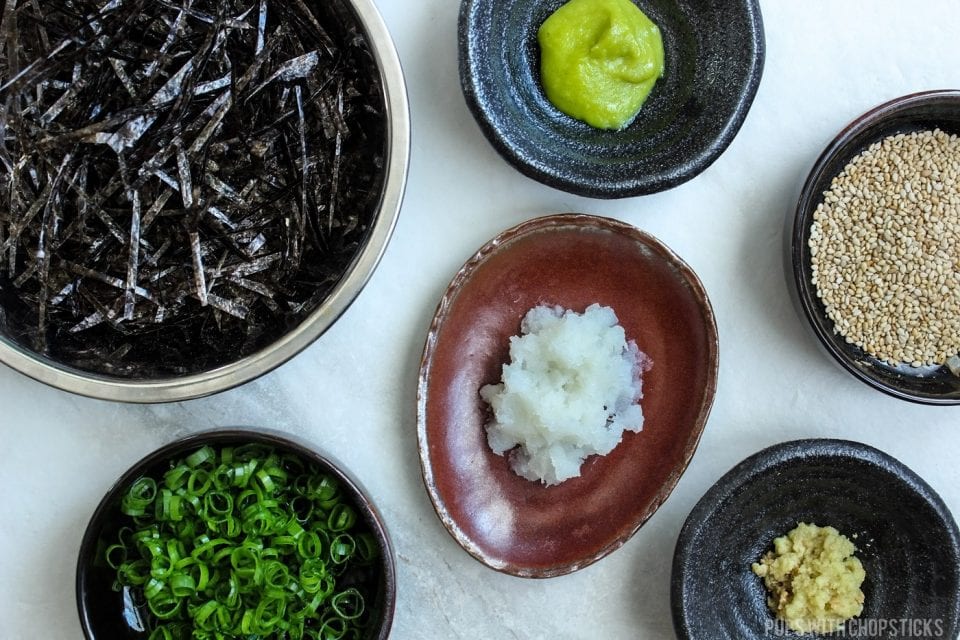
Here are some additional topping ideas:
- Nori - I found it easiest to use scissors to snip them up into small slivers
- Grated ginger and daikon - Use a fine grater to grate it. Once grated, they have a lot of excess water - squeeze and drain the excess liquid out.
- Finely chopped green onions/scallions
- Wasabi - Fresh and pre-made store-bought wasabi will work.
- Toasted Sesame Seeds - This adds a nice nuttiness to the sauce
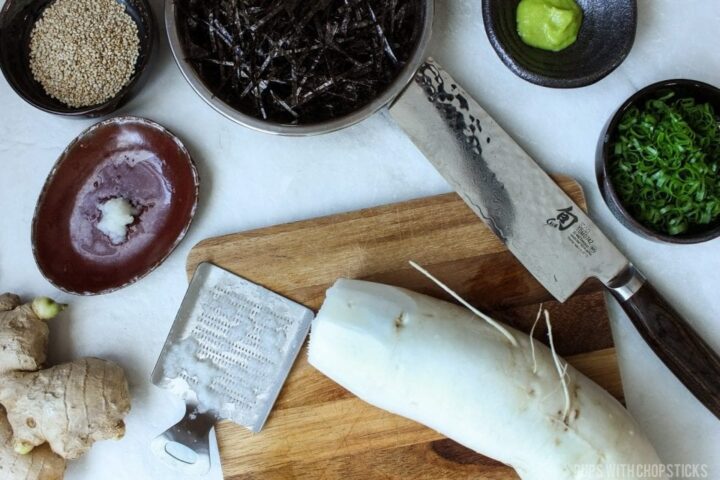
Make Zaru Soba Dipping Sauce
- Steep approximately 4 tablespoons of genmaicha tea in 3 cups of hot water for about 15 minutes. I have a huge tea ball but ideally, you would want to put this in some sort of tea ball or tea bag. If you don't have one you can strain out the tea leaves with a strainer once the tea has been steeped.
- Once the tea is done, in a pitcher add in about a handful of bonito flakes (approx. 4 tbsp), pour in the tea, and let it steep for about 10-15 minutes
- Strain the bonito flakes out, then add in the soy sauce, mirin, and sake
- Let the sauce chill in the fridge for about an hour.
Cooking the Soba Noodles
- In a pot, add water and set it on medium heat until the water boils. Do not add salt to the water - the dipping sauce is already very salty so we don't want to go overboard with the salt.
- Follow the directions on the packaging to cook the soba noodles. I usually cook it for 1 minute less than it says and then taste it for doneness to make it al dente. Make sure to watch the noodles like a hawk. They boil over very easily. When you start to see the foamy bubbles rise up, gently blow into it - it's weird but it works, it makes the bubbles die down a bit.
- Once the noodles are done, run them under cold water and rinse off all the starches.
- When the noodles are cool, add them to an ice bath for a few minutes. It is not traditionally added but I also add a few drops of sesame oil to the ice bath because it adds a nice nutty flavor. A little goes a long long way, so less is more. Start by adding a few drops into the water. Use no more than ¼ teaspoon. The sesame oil also helps prevent the noodles from sticking to each other as well.
How To Serve and Eat Cold Soba Noodles
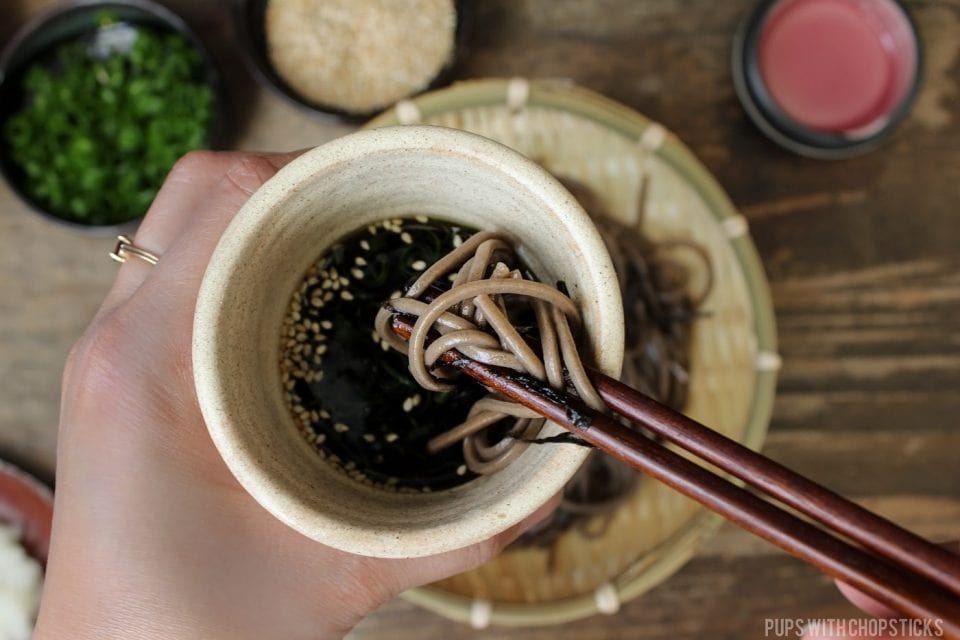
- Place the Cold Buckwheat Noodles, Tsuyu Sauce, and Toppings on the Table - Once you have finished cooking the noodles, and the noodles have had time to chill, place them on a small plate or basket and set it on the table. Place the toppings/garnishes and tsuyu dipping sauce at the table as well.
- Prepare the Small Dipping Sauce Bowls - Using a small bowl, put in a few of your favorite garnishes (wasabi, toasted sesame seeds, grated daikon radish, green onions, and grated ginger). Pour the tsuyu dipping sauce into the bowls.
- Dip the Noodles in the Sauce and Slurp Up the Noodles! - Take a small amount of noodles and dip it in the sauce you just created! Then slurp up the noodles and enjoy!
Make a Soup with the Remaining Tsuyu Dipping Sauce
When the meal is done, you will most likely have a lot of dipping sauce left. Traditionally, zaru soba would use the leftover soba noodle water (sobayu) to water down the dipping sauce to make it into a soup! Instead of the soba water, I re-steeped the tea in a teapot and used that to water down the dipping sauce to make the soup instead.
Recipe Variation Ideas for Cold Soba
This delicious cold soba recipe is so flavorful and easy to make, you'll want to try out some of these delicious variations! Here are some great ideas:
Spicy: Mix in sriracha or red pepper flakes to the tsuyu dipping sauce before serving for an extra kick of heat.
Citrus: Add a squeeze of fresh lemon or lime juice to the sauce for a refreshing burst of citrus flavor.
Sesame: Sprinkle toasted sesame seeds over the finished dish for a nutty and aromatic twist.
Vegetables: Toss in your favorite vegetables, like sliced cucumbers, shredded carrots, and blanched broccoli, to add a colorful and nutritious element to the dish.
Protein-packed: Top the cold soba noodles with grilled chicken, tempura shrimp, or tofu for a satisfying and filling meal.
How to Store Leftover Cold Soba
To store leftovers, first, allow the noodles to cool down completely before transferring them to an airtight container. Place the container in the refrigerator and store for up to 3 days. When ready to eat, remove the container from the fridge and let the noodles come to room temperature.
If desired, you can add a splash of warm water to help loosen them up. The noodles can be eaten cold or quickly reheated by placing them in a microwave-safe dish and heating in short intervals until warmed through.
Unfortunately, soba noodles are typically not recommended for freezing as they tend to become mushy and lose their texture when thawed. It is best to enjoy the leftovers within a few days of making the dish.
More Japanese Recipes You May Like
- Kani Salad (Japanese Crab Salad)
- Chicken Teriyaki Yaki Udon
- Charred Lemon Garlic Edamame
- Sesame Crusted Teriyaki Salmon
- Homemade Furikake Seasoning
- Maple Curry Yaki Udon
- Japanese Curry Udon
Did You Make This Japanese Cold Zaru Soba Noodle?
If you made this Japanese Cold Soba Noodle recipe, I want to see! Follow Pups with Chopsticks on Instagram, snap a photo, and tag and hashtag it with @pupswithchopsticks and #pupswithchopsticks. I love to know what you are making!
If you like my recipes and want to be updated on when new ones come out, please consider subscribing to my newsletter (we don't spam) and follow along on Instagram, Facebook, and Pinterest for all of my latest recipes!
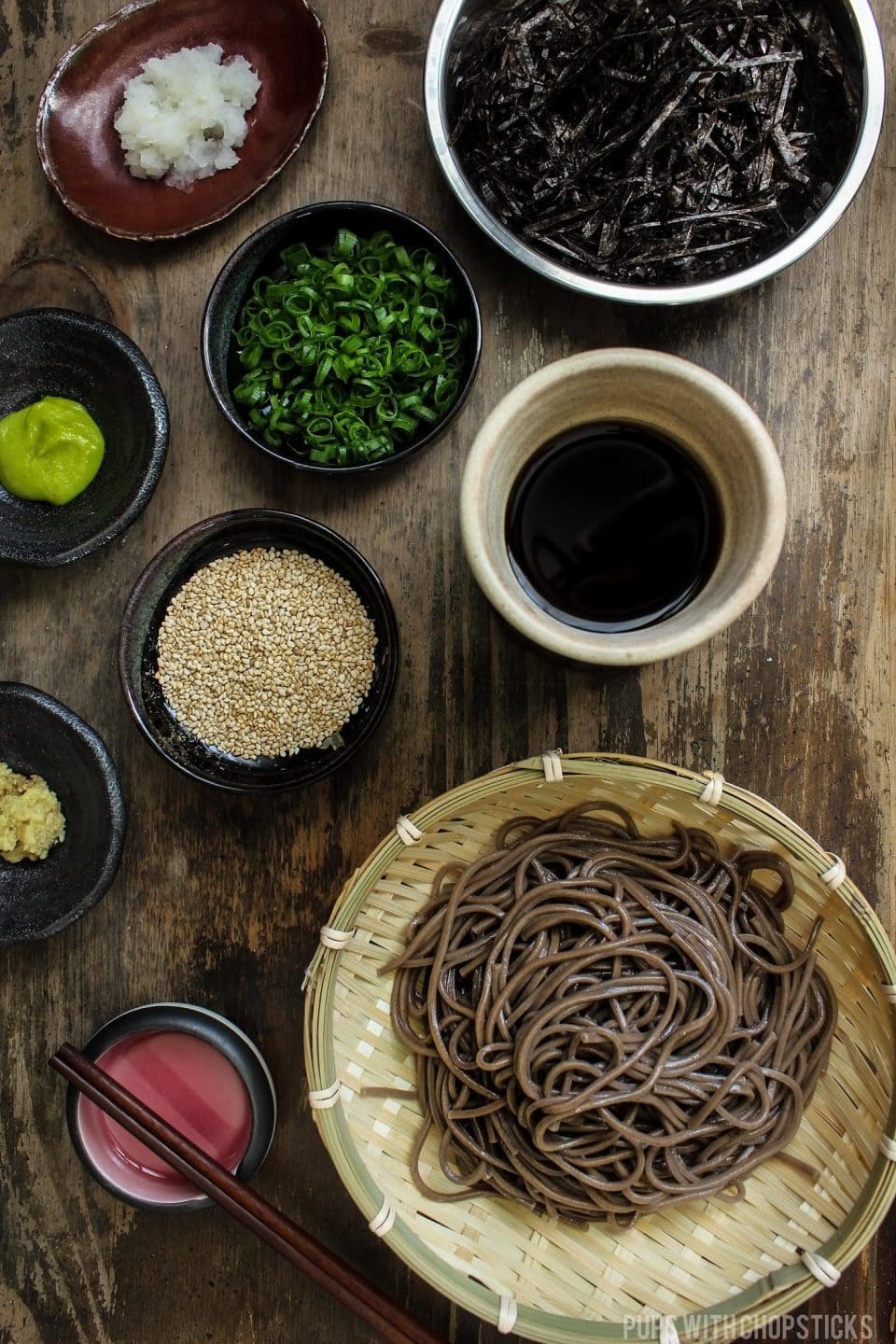
Recipe Card
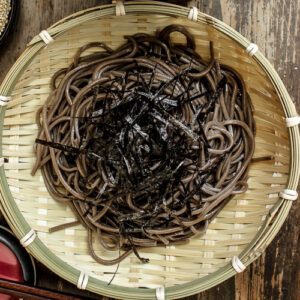
Easy Cold Soba Noodles (Zaru Soba)
Joyce's Recipe Notes
- When boiling the noodles, watch it like a hawk. They boil over very easily. When you start to see the bubbles/foam rise up, gently blow into it and it will reduce the foam in the pot and prevent it from overflowing the pot.
- Sesame oil during the ice bath is optional. It is not traditionally added but I find a hint of nuttiness adds a nice flavor to the noodles. A little goes a long long way, so less is more. I would go with only adding a few drops in and use no more than ¼ teaspoon.
- Just a warning, prepared wasabi is potent – a little goes a long long way, so use it sparingly as a topping.
- If you have Hondashi granules, you can also use ¾ teaspoon to the tsuyu sauce to give it a smokier flavor.
Ingredients
- 180 g soba noodles (2 individual bundles)
- ¼ teaspoon sesame oil (optional)
Genmaicha Tsuyu Dipping Sauce
- 4 tablespoons genmaicha tea (roasted brown rice Japanese green tea)
- 3 cups water (hot)
- 4-5 tablespoons bonito flakes
- ½ cup soy sauce
- ½ cup mirin
- 1 teaspoon sake
Toppings (Pick and choose the ones you like!)
- 2 x2cm ginger (grated)
- 1 sheet dried nori seaweed sheet (cut into slivers)
- 1 tablespoon toasted sesame seeds
- 5 x5 cm daikon radish (grated)
- 1 teaspoon wasabi
- 1 stalk green onions (finely chopped)
Instructions
Make the Zaru Soba Dipping Sauce
- Steep approximately 4 tablespoons of genmaicha tea in 3 cups of hot water for about 15 minutes. Ideally you would want to put this in some sort of tea ball or teabag. If you don’t have one you can strain out the tea leaves with a strainer once the tea has been steeped.
- Once the tea is done, in a pitcher add in about a handful of bonito flakes (approx. 4 tbsp), pour in the tea and let it meld for about 10-15 minutes
- Strain the bonito flakes out, then add in the soy sauce, mirin, and sake
- Let the sauce chill in the fridge for about an hour.
Prepare the Toppings
- Pick and choose the toppings you like. You don't need to use them all. If you want to keep it simple, green onions (scallions) and seaweed (nori) is more than enough for some good flavourings.
- If you are using seaweed, I found it easiest to use scissors to snip them up into slivers
- For ginger and daikon, use a fine grater to shave it into mush. Once grated, they have a lot of excess water – squeeze and drain the excess liquid out.
Cooking the Soba Noodles
- In a pot, add water and set it on medium heat until the water boils. Do not add salt to the water – the dipping sauce is already very salty so we don't need the extra saltiness.
- Follow the directions on the packaging to cook the soba noodles. I usually cook it for 1 minute less than it says and then taste it for doneness to make it al dente
- Once the noodles are done, run them under cold water and rinse off all the starches. When the noodles are cool, add them into a ice bath for 1 minutes.It is not traditionally added but I also add a few drops of sesame oil to the ice bath because it adds a nice nutty flavour. A little goes a long long way, so less is more. Start by adding a few drops into the water. Use no more than ¼ teaspoon. The sesame oil also helps prevent the noodles from sticking to each other as well.
Serving the Noodles
- Place the Cold Buckwheat Noodles, Tsuyu Sauce, and Toppings at the Table - Once you have finished cooking the noodles, and the noodles have had time to chill, place them on a small plate or basket and set it at the table. Place the toppings/garnishes and tsuyu dipping sauce at the table as well.
- Prepare the Small Dipping Sauce Bowls - Using a small bowl, put in a few of your favorite garnishes (wasabi, toasted sesame seeds, grated daikon radish, green onions, grated ginger). Pour the tsuyu dipping sauce into the bowls.
- Dip the Noodles in the Sauce and Slurp Up the Noodles! - Take a small amount of noodles and dip it in the sauce you just created! Then slurp up the noodles and enjoy!
- Make a Soup with the Remaining Dipping Sauce - When the meal is done, you will most likely have a lot of dipping sauce left. Traditionally, zaru soba would use the leftover soba noodle water (sobayu) to water down the dipping sauce to make it into a soup! Instead of the soba water, I re-steeped the tea in a teapot and used that to water down the dipping sauce to make the soup instead.
Nutrition
*Nutritional information is calculated using online tools and is an estimate*
Disclaimer: We are a participant in the Amazon Services LLC Associates Program, an affiliate advertising program designed to provide a means for us to earn fees by linking to Amazon.com and affiliated sites, however I provide these links to make items easier to find if you cannot purchase this locally and I would never recommend anything I don’t own myself or highly recommend. I would prefer you buy your items locally if possible to support your local shops (and chances are they are cheaper locally as well!) 🙂
Other Noodle Recipes You May Like
- Easy Japchae (Korean Glass Noodles Stir Fry)
- Singapore Noodles (Singapore Mei Fun)
- Delicious Homemade Udon Soup (Quick & Easy Noodle Soup)
- Beef Chow Fun (干炒牛河)
- Garlic Noodles
- Crispy Cantonese Beef Chow Mein
- Bun Bo Hue (Spicy Vietnamese Beef Noodle Soup)
- Chicken Khao Soi Recipe (Thai Coconut Curry Noodle Soup)

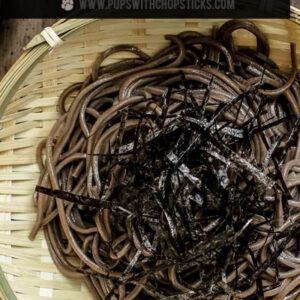
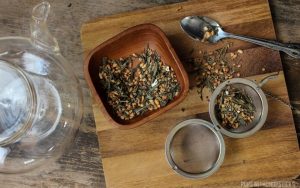
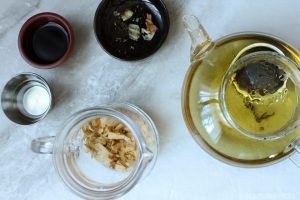
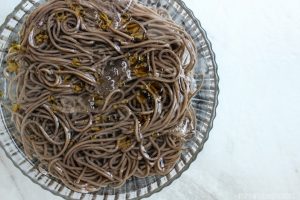
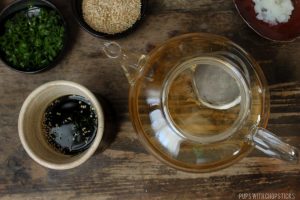
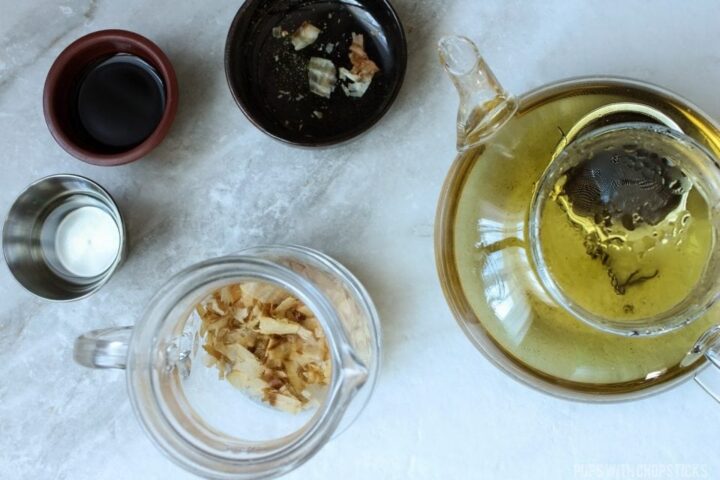
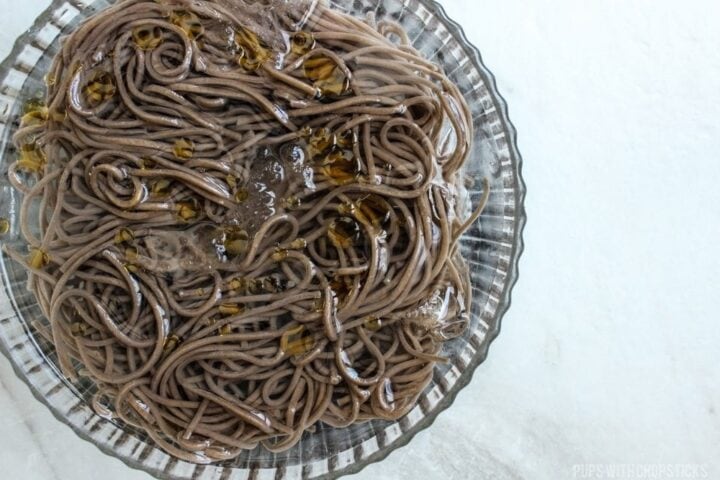
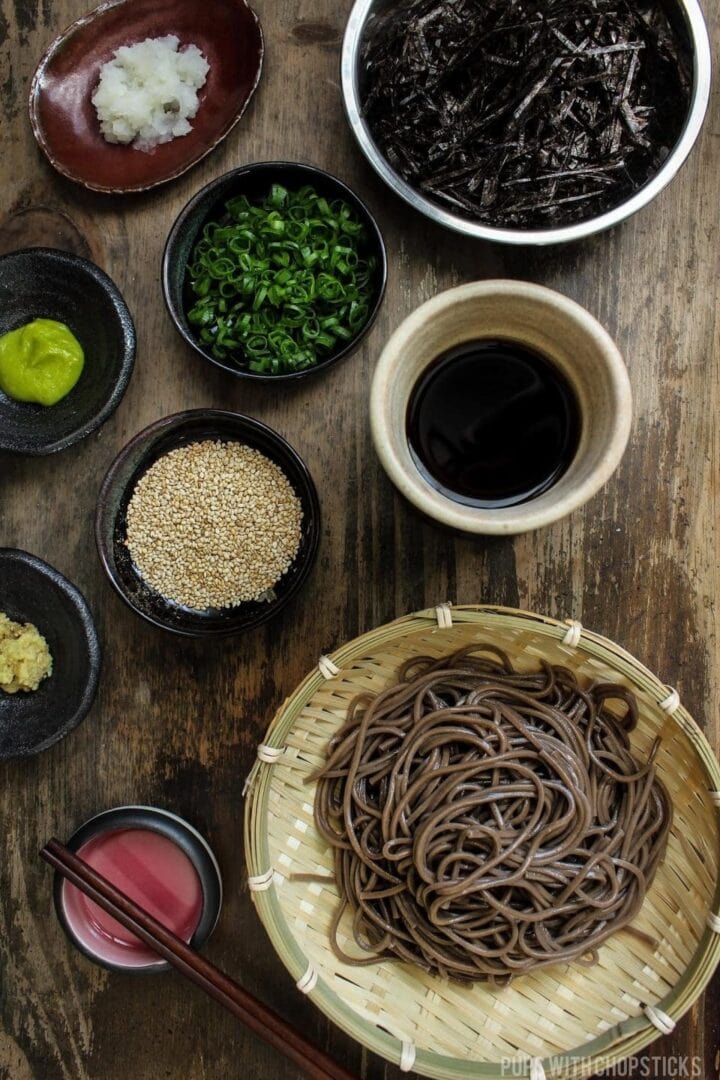
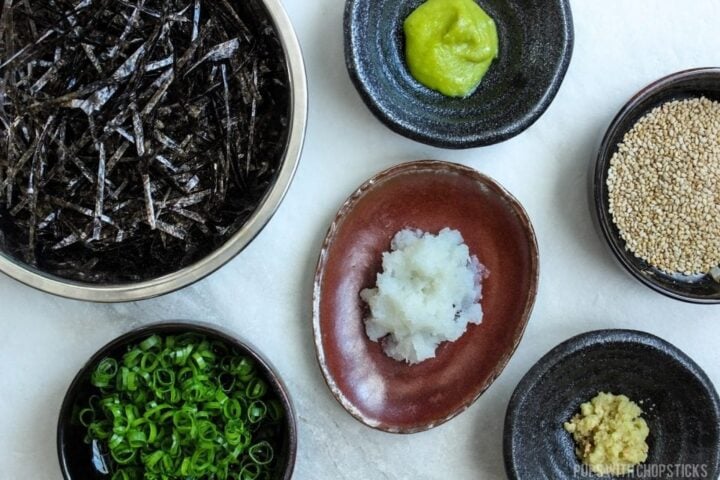
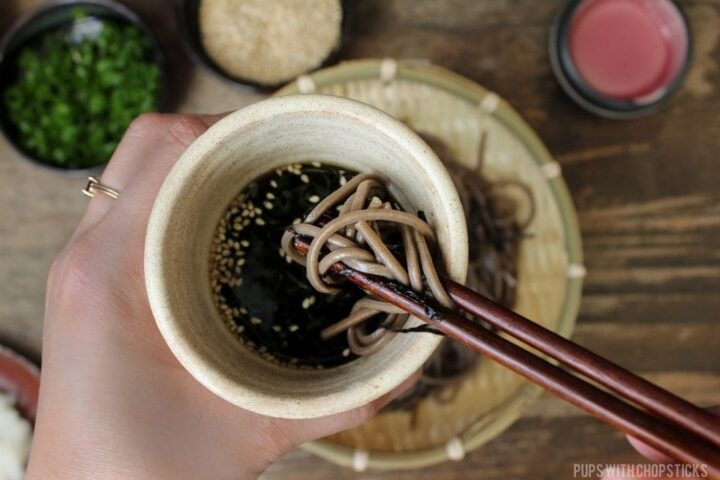
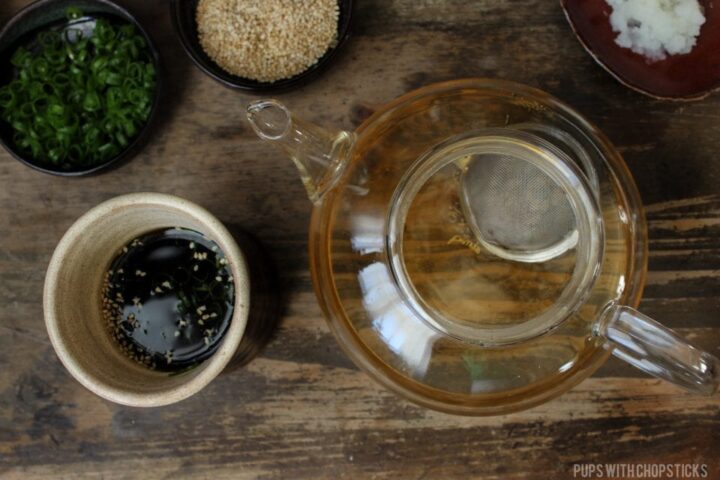
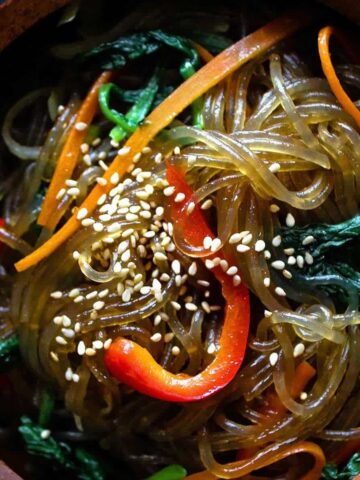
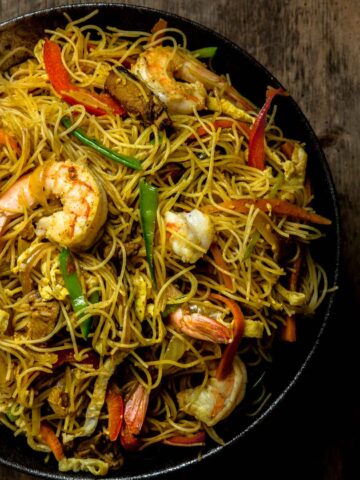
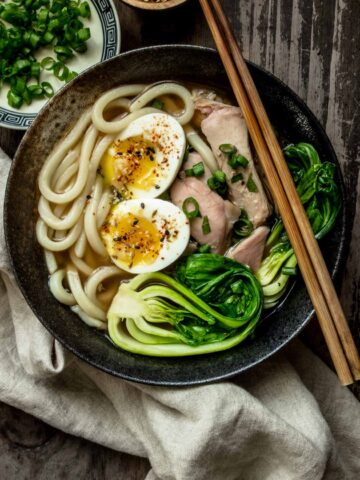
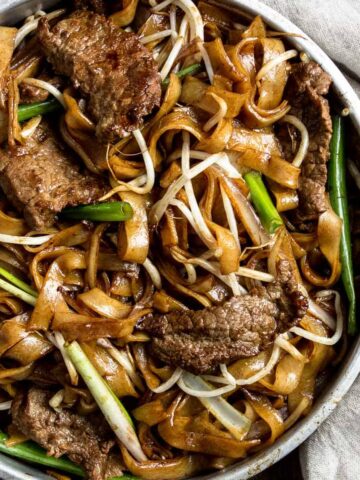
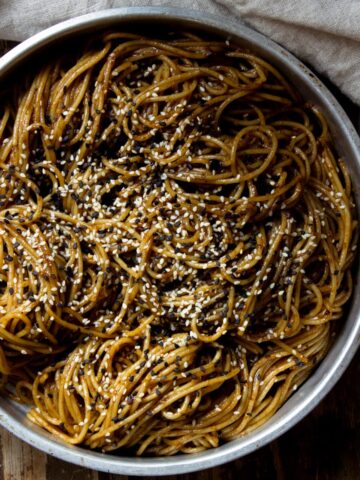
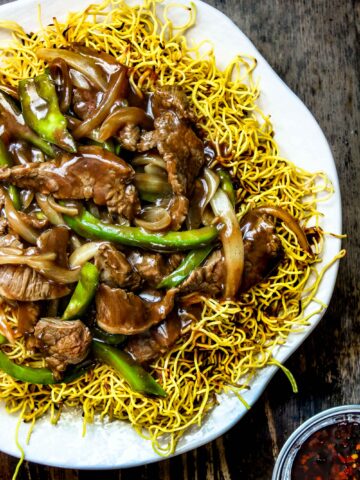

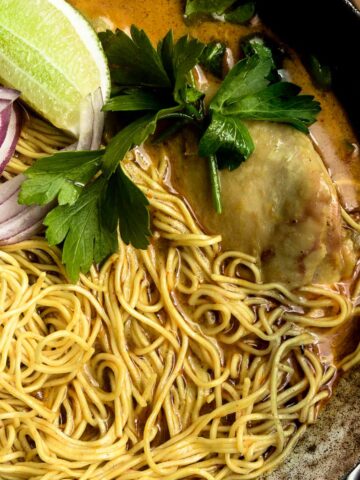
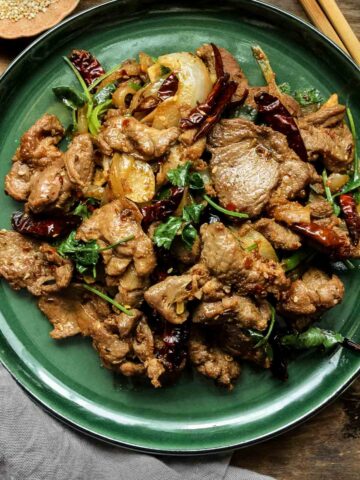
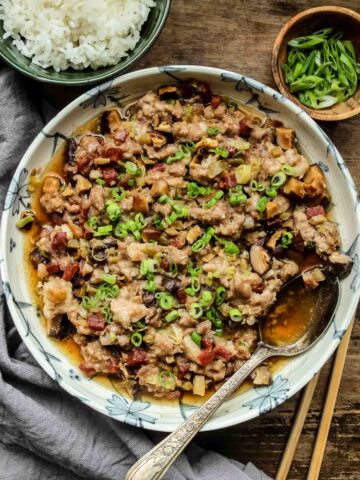
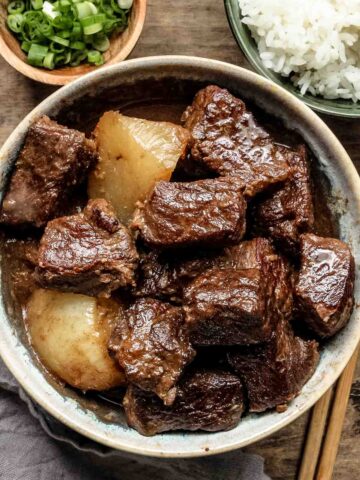

great bbq restaurants says
Barbecue is one of the most American dish that Americans eat. There are numerous regional variations, such as the Memphis sticky ribs and Central Texas smoked brisket, and Kansas City's burnt ends, and the Carolinas vinegar and mustard-sauced meats. The famous cuisine is more than meets the eyes.
Wanda says
So many great flavours here I must try this recipe! Thanks for sharing!
Catherine says
What a beautiful and elegant dish...I'm so intrigued by this. Would love to try!
Allison Mattina says
I've not been able to bring myself to try these noodles yet! The color throws me off but I've heard they're so good.
Joyce says
haha yes the dark colour is from the buck wheat flour 🙂 Definitely something you should try, it taste like any other noodle but a lot more nutty.
Marisa says
I tried toasted rice tea for the first time last year. Great idea to cook with it for savory flavor. Loved this... and learned lots!
Deepika says
I am intrigued by how this recipe is made. This is definitely on my Must- Try List. Thanks for sharing. 🙂
Josie says
I love this healthy dish, fast making for lunch or dinner. I can put in less wasabi for my own taste. Simple healthy and fast especially if I don't want to make a more complicated mundane food. Thanks.
Joyce says
I definitely put too much wasabi in mine haha! Lesson learned! 🙂